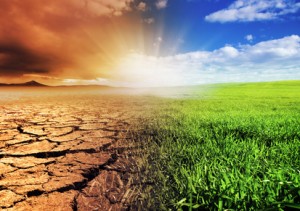Introduction
The modern environmental movement in Europe began in the 1960s and 1970s, and matured in the 1980s and 1990s. During this period, The Netherlands stood out, with a few other countries, in forging ways to do more for environmental policies and practices, while some countries, including the Republic of Ireland, spent the 1980s and 1990s looking for ways to do less for environmental protection. So when the Dutch environmental agency decides that it needs to rethink its approach to environmental protection to do even more, it is worth listening to what it says.
In a recent report, Changing track, changing tack; Dutch ideas for a robust environmental policy for the 21st century, the PBL Netherlands Environmental Assessment Agency starts a conversation on the modernisation of environmental policy. Climate change, threats to nature (biodiversity) itself, and natural resource scarcity are leaving us all vulnerable in ways we never were in the past, and the past ways of dealing with environmental threats do not seem to be working.
While we once might have thought that we could tame nature, so we could live better, the way we live abuses nature and it is about to punish us like an avenging angel. As Pope Francis said in his recent State of the World address: “God always forgives, we sometimes forgive, but when nature — creation — is mistreated, she never forgives.”
As with any such broad think piece, with a visionary perspective, the language and ideas of the report can be abstract, but there is sufficient concrete analysis and possibilities here to be useful for other governments, and those of us continuing to try to figure out what to do and how to talk about it. It is a thoughtful report.
Think Local, Act Global
The Dutch report states that they have “solved,” in the sense of significantly improved, certain environmental problems. Soil and water pollution seem more under control as does waste disposal, there is less smog and ozone depletion, and uncontrolled dumping of toxic chemicals everywhere has significantly lessened. This is probably fairly accurate for a number of the EU 15 Members. As the authors note, “[e]nvironmental policy has become, to some extent, a victim of its own success.” At 37. If our air is cleaner and water clearer, why would we need more environmental regulation?
But much remains to be done. We still have serious air pollution problems, with particulate matter (PM) from the transport sector continuing to cause considerable harm, and we will always have the impacts from environmental disasters such as the BP oil spill in the Gulf of Mexico and the Fukushima nuclear incident. Excessive nitrate leaching and eutrophication of water bodies, especially from agricultural practices, remain problematical.
Above and beyond these unfortunately familiar, primarily local, disasters, there are the big international disasters-in-waiting: climate change, loss of biodiversity, and resource scarcity.
The wider interconnectedness of things and people is a change from what we faced in the past. The economies of the world are now tightly interwoven and interdependent and the bigger companies are multi-national, and people everywhere depend deeply on increasingly scarce natural resources, from sunlight to petroleum, fertile soil, water — for drinking, farming and industry — minerals, and fish. Many of these natural resources cross boundaries and nations and continents. Following all of these developments is a wired, internet-connected, smart-phone world citizenry.
The traditional slogan, or rally cry, “To think global, act local” means to consider the health of the entire planet and to take action in one’s own community or city. The Dutch report, without saying so, would suggest perhaps that we need “To think local, act global.” That is, only action at the global or very large level will provide the means for addressing what are increasingly global environmental problems, especially climate change.
The Overarching Climate Change
Climate change is changing everything and it acts as a super-charged motor driving environmental threats in lots of places, all global and interconnected, all seemingly intractable at times.
In the past we have had to deal with air pollution seriously affecting local areas, like in the EU and US in the post-war period and currently in China. The sources of the pollution and the impacts generally were local, and could be fixed by the local or national government. Now we face the consequences of everybody everywhere spewing CO2 and other GHGs into the world’s atmosphere. The fix is not so clear.
Energy policies in the EU, US, Russia, and China, and elsewhere, have environmental consequences in remote areas as well as in capital cities around the world. A EU decision on the carbon intensity of tar sands will affect GHG emissions and the economy of parts of western Canada. The US expansion of cheap shale gas production is leading to the exporting of US coal overseas where it is cheaper than other forms of energy. The US coal is burnt outside the US but comes back to the US to bite it in its behind from GHG emissions. A recent study was able to quantify how air pollution in the western US is adversely affected by pollution from China’s production of goods for export which in turn is driven by global consumer demands for these goods, including consumers in the US. See Sources, New York Times (21 Jan 2014). We are what we eat.
Habitats of many species have been threatened, and destroyed, for a long time by human activities, including real estate developments. But shifts in climate are forcing species around the world to move or die on a massive scale.
Population increases and a growing global middle class are leading to more consumer consumption that requires the exploitation of natural resources to make things. Many of these natural resources are at risk as a result of climate change, including by increased flooding and droughts.
The Dutch report, not surprisingly, rejects “political fatalism” and looks for ways to confront these new challenges.
Coalitions of the Willing
The challenge in thinking local and acting global, to deal with the international dimension to modern environmental threats, is that there is no international government to speak for or protect the public interest. Through what medium, then, does one act globally? The PBL report notes that there are three “public forces” supporting environmental efforts and they can act as “coalitions of the willing,” or groups of people or institutions that can act collectively.
First, there are international institutions working to protect natural resources and to address climate change issues, including the World Bank, the IMF, the IEA, and the OECD. The World Bank has put climate change at the center of its mission, citing rising global poverty and falling GDPs in developing countries because of climate changes. The IMF has reported on the billions of dollars of environmentally damaging subsidies and fiscal advantages for industries. We may not always, even often, agree with specific analyses, policies or projects of these institutions, nevertheless they have been promoting progressive policies on energy efficiency, carbon taxes, and other climate issues. They also provide a global perspective to the issues, which is often missing from national and local policies.
Second, internationally-operating companies are showing greater sensitivity to their reliance on natural resources. More and more industry is, quite literally, buying into the risks from climate change that are very quickly eating into their bottom lines. A recent article in the New York Times pointed out that when Coca Cola lost a valuable contract in 2004 in India because of a serious water shortage, the company began to wake up to the larger risks from climate change, including disruptions to supply of raw materials (sugar cane, beets, citrus) because of droughts and flooding. Nike has 700 factories in 49 countries, many in Southeast Asia, and as a result of disruption to its cotton supply chain from extreme weather it has now reported these problems on its financial disclosure forms with the US Securities and Exchange Commission. See Sources (New York Times, 24 Jan 2014). Of course, the insurance industry has been sensitive for some time to climate changes already impacting on its business.
Some companies have committed to investing in innovative sustainable technologies, e.g., wind and solar companies, and Internet Technology companies. They typically support tough, tight climate targets that serve their interests. Some companies have invested in traditional technologies, e.g., fossil fuel energy or cement plants, and want to delay regulations and targets until their investment earns its full return, and they often plan to replace older polluting plants or processes, perhaps even with more sustainable versions, once their investment is paid off. They typically want to delay targets and regulations. We can work with their long-term goals at the same time that we insist on short-term targets. Some continue to invest in polluting processes, e.g., oil, gas, coal mining, extraction, and production, and they have every intention of continuing until all their fossil fuels are extracted and burned and emitted into the atmosphere. They want to fight to the death, like the Koch Brothers in the US. The PBL report notes that the most resistant companies are subject to strong international competition and small profit margins, including the steel industry, intensive livestock farming, and road transport.
It may be useful to learn to differentiate between the willing industries and work with them to advance their interest to the extent it aligns with the public interest. At the same time, it may be useful to publically condemn the coalitions of the unwilling.
The third, and final, “public force” is the public itself which the PBL report finds engaging in a myriad of initiatives to build a sustainable society through individual action and cooperatives, and through action at municipal level, which remains closer and often more responsive to local sustainable actions. By 2050 it expected that 70% of the global population will live in urban areas. It is already 80% in the US. Such urban areas are centers of economic and cultural power and influence, often with progressive environmental policies. Already there are global movements to enact sustainable policies and practices at the municipal level, including C40, a network of the world’s megacities taking action to reduce greenhouse gas emissions, and ICLEI, a global association of cities and local governments dedicated to sustainable development.
Eco-innovation for sustainable cities
Other Actions
The critical action, for the Dutch and almost every progressive voice, is a carbon tax or other economic mechanism for putting a price on carbon emissions. The PBL report urges that any proceeds from a carbon tax, or something like a gas revenue fund, be applied to stimulate eco-innovation, or sustainable technology. The focus needs to be on eco-innovation that will drive practices in the long-term. The report argues that it makes no sense investing in short-term technological fixes that actually aggravate more critical long-term fixes. As the report notes: “Policy cannot continue to focus on achieving short-term goals if these have little effect in the long term…If we need a low-carbon energy supply by 2050 … then innovation is more important than achieving goals for 2020 through the co-firing of biomass in (old) coal-fired power plants. Money could be better used to develop more innovative forms of sustainable energy generation.” At 10. Carbon capture and storage (CCS) represents an innovative long-term development.
Other economic tools discussed in the report include cutting subsidies for fossil fuels, Green accounting, and the need for certainty and consistency. When companies face rising prices for resources, they innovate. When salaries rise, companies invest in labor-saving practices or goods; when oil prices rise, companies and people invest in energy-savings products, including efficient cars.
Many call for behavior changes, especially for consumers since this is a way for them to contribute to the climate change solution. The Dutch report acknowledges that people cannot be forced to change, but that some pressure is acceptable by people when they are given clear and adequate information about the impacts of their consumption on the environment. Force won’t do, but nudging may not be enough. They offer the examples of energy efficiency labels and Green Public procurement by governments (setting by example). While the report suggests force will not work, perhaps force is undervalued, as we require people to drive at lower speeds, through regulation and enforcement, and that seems productive. As does banning smoking in public places.
Contrary to others who are reluctant to use scare-mongering language or tactics, the Dutch report argues that if people will not pay attention to the dire consequences of a world where the global temperature will rise by 2°C, maybe we need to let them know, directly and graphically, what our world will be like with a 4°C or 6°C temperature rise.
It is also encouraging to hear the Dutch report stress that while we may have solved some environmental problems and we need to enter into coalitions of the willing with businesses and others, nevertheless we still need more investment in monitoring and enforcement of the environmental laws that we have and will need to address climate change. The report advocates for strict liability for environmental impacts, a legal standard prevalent in the US environmental regulatory regime and US common law. Of course forms of strict liability are also embedded in EU law with the polluter pays principle, as well with aspects of the Registration, Evaluation, Authorisation and Restriction of Chemicals (REACH) program which places responsibility and burden of proof on companies to manage risks from chemical substances they manufacture or market in the EU. Oversight and enforcement regimes are all the more important since global economies and multi-national corporations, with internet technology, are moving at lightening speed and even national governments cannot keep up with threats to our natural resources, especially with growing pressures to reduce governmental expenditures.
Under such circumstances, it is important, as the report notes, that we are not naïve about self-regulation which can lead to abuses and criminal conduct, as with illegal dumping of toxic wastes. Moreover, the report calls for industry to be transparent with the public about the make-up of its products, as in REACH program, and impacts from its production methods. This would make it easier for members of the public to assist government agencies in monitoring the practices and compliance of companies. Modern technology, including smart phones (with apps, GPS and cameras), can assist in a wider and more effective citizen watch that provides critical information and support for governmental enforcement.
iPhone with device for measuring PM concentration
Underlying the report is the recognition that the dominant economic view over the past few decades has been that “governments should leave business to businesses,” what some would call a neo-liberal view. Whatever effects it had, the report points out that it was “not a successful recipe for creating breakthrough technologies with market potential.” At 33. In many cases, private investors avoided developing technologies since they could eventually reap the benefits of such breakthroughs without engaging in the risks.
Implications
The report stresses the funding and development of radical innovations to reduce use of natural resources (inputs), by a factor of five, to reduce hazardous emissions (outputs), and to develop sustainable alternatives. We have seen the results of concerted government research and development funding of new technologies with airplanes, lasers and computers, and the massive conversions in manufacturing for WW II. Is climate change any less a threat than WW II?
Besides governmental investment in eco-innovation, we need internationally-operating businesses , and “critical, articulate,” and, we would add, “active” citizens” to modernize environmental policies and practices.
Having said a few complementary things about responsible companies, it is useful to add that even responsible companies have to be watched to ensure compliance with environmental laws and regulations. Self-interest drives all our behavior, and the profit motive is the prime mover of corporate behavior. Government oversight agencies need to watch the companies, and citizen groups need to be vigilant of the government agencies.
Since multi-national corporations exercise an increasingly important role in creating, and resolving, global environmental challenges, perhaps it is time for environmental Non-Government Organisations (eNGOs) to organize on a global basis to serve as a counteracting force. Cities are doing it as we note above. If so, room should be made not just for the big national eNGOs but also for representative grassroot organizations. In the fight against the Keystone XL pipe, for carrying tar sand oil from Canada to the refineries in Texas, there has been a merging of the big eNGOs with many grassroots groups in US and Canada to form an activist opposition, with people like James Hansen and Bill McKibben and thousands more subjecting themselves to arrest. The memberships and fundraising of eNGOs have increased significantly as a result.
Sources
Nico Hoogervorst, Maarten Hajer, Frank Dietz, Jacqueline Timmerhuis, Sonja Kruitwagen, Changing track, changing tack; Dutch ideas for a robust environmental policy for the 21st century PBL Netherlands Environmental Assessment Agency (18 Oct 2013).
“REACH” in the iePEDIA section of the current issue of irish environment (February 2014)
World Bank “Climate Change.” www.worldbank.org/en/topic/climatechange
World Bank, Turn Down the Heat: Why a 4°C Warmer World Must Be Avoided, A Report for the World Bank by the Potsdam Institute for
Climate Impact Research and Climate Analytics (November 2012). www-wds.worldbank.org/external/default/WDSContentServer/WDSP/IB/2012/12/20/000356161_20121220072749/Rendered/PDF/NonAsciiFileName0.pdf
See “Carbonification, or How We Are Condemning Ourselves to Hell Because of Our Lust for Carbon,” in the Reports section of irish environment (December 2012), on the World Bank, and other studies. www.irishenvironment.com/reports/carbonification-or-how-we-are-condemning-ourselves-to-hell-because-of-our-lust-for-carbon/
IMF, Energy Subsidy Reform: Lessons and Implications (January 2013). www.imf.org/external/np/pp/eng/2013/012813.pdf
C40CITIES, Climate Leadership Group www.c40.org/about
ICLEI-Local Governments for Sustainability (originally “International Council for Local Environmental Initiatives. www.iclei.org/
Sustainable Cities, sustainablecities.net/
Coral Davenport, “Industry Awakens to Threat of Climate Change,” New York Times (24 Jan 2014).
“The pope is writing a big green manifesto,” grist.org/news/the-pope-is-writing-a-big-green-manifesto/
Edward Wong, “China Is Also an Exporter of Pollution to Western U.S., Study Finds,” The New York Times (21 Jan 2014). www.nytimes.com/2014/01/21/world/asia/china-also-exports-pollution-to-western-us-study-finds.html
Sarah Wheaton, “Pipeline Fight Lifts Environmental Movement,” The New York Times (25 Jan 2014).
UPDATE – 02 Feb 2014
“Former NY mayor Michael Bloomberg tapped to be UN envoy for cities and climate change,” The Guardian 31 Jan 2014
www.theguardian.com/world/2014/jan/31/michael-bloomberg-cities-climate-change-un-envoy




No comments yet, add your own below